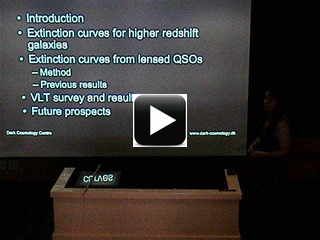Dust extinction causes light from distant sources to be dimmed on its
way to the observer. In cosmological studies, such as SN Ia studies,
it is of great importance that the effects of dust extinction be
correctly accounted for. However, although dust properties, and
hence extinction, are expected to vary with redshift, not very much
is known about the extinction properties of high redshift galaxies.
This is because the methods traditionally used to study extinction
curves are only applicable for the most nearby galaxies. Studying
gravitationally lensed quasars is an emerging method of studying the
dust extinction of high redshift galaxies. I will present an ESO VLT
study of 10 such lensing galaxies, with redshifts up to 1. The 10
systems display varying amount and type of extinction, with the
doubly imaged quasar B1152+199 showing the greatest extinction with A
(V)=2.4 and R_V=2.1 for a Galactic type extinction law.
 Other video options
Other video options
To begin viewing slides, click on the first slide below. (Or, view as pdf.)
![[01]](tn/01.gif)
![[02]](tn/02.gif)
![[03]](tn/03.gif)
![[04]](tn/04.gif)
![[05]](tn/05.gif)
![[06]](tn/06.gif)
![[07]](tn/07.gif)
![[08]](tn/08.gif)
![[09]](tn/09.gif)
![[10]](tn/10.gif)
![[11]](tn/11.gif)
![[12]](tn/12.gif)
![[13]](tn/13.gif)
![[14]](tn/14.gif)
![[15]](tn/15.gif)
![[16]](tn/16.gif)
![[17]](tn/17.gif)
![[18]](tn/18.gif)
![[19]](tn/19.gif)
![[20]](tn/20.gif)
![[21]](tn/21.gif)
![[22]](tn/22.gif)
![[23]](tn/23.gif)
![[24]](tn/24.gif)
![[25]](tn/25.gif)
![[26]](tn/26.gif)
![[27]](tn/27.gif)
![[28]](tn/28.gif)
![[29]](tn/29.gif)
![[30]](tn/30.gif)
![[31]](tn/31.gif)
![[32]](tn/32.gif)
![[33]](tn/33.gif)
![[34]](tn/34.gif)
![[35]](tn/35.gif)
![[36]](tn/36.gif)
![[37]](tn/37.gif)
![[38]](tn/38.gif)
![[39]](tn/39.gif)
![[40]](tn/40.gif)
![[41]](tn/41.gif)
![[42]](tn/42.gif)
![[43]](tn/43.gif)
![[44]](tn/44.gif)